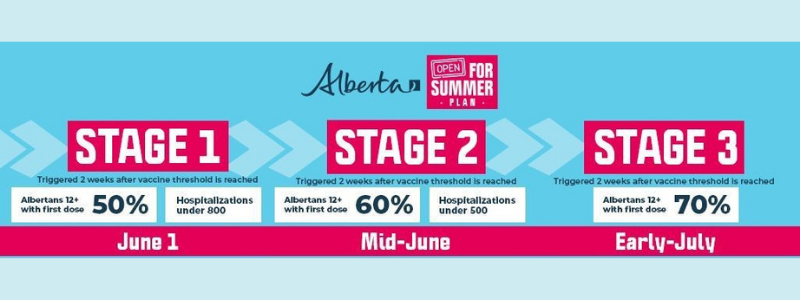The Alberta Recreation and Parks Association, in collaboration with the Alberta Health representatives, hosted a Town Hall on June 3rd to answer questions and give clarifications about the public health measures of the province’s Open for Summer Plan. Concerning this, we made a roundup of key points discussed for those who missed the town hall. Or you can watch the full recording here.
Alberta’s Open for Summer Plan
The Open for Summer Plan is a 3-stage plan tied to vaccinations and a declining hospitalization rate.
- Stage 1, the stage we are currently in, was triggered by having 50% of Albertans 12+ received at least one vaccine dose, and hospitalizations are below 800 and declining.
- Stage 2 reopening is expected to start on June 10th (earliest possible), with 60% of Albertans 12+ having received at least one dose of vaccine and hospitalizations below 500 and declining. For details on restrictions for Stage 2 of the Open for Summer Plan and updates, refer to the COVID-19 info on Alberta’s website.
- Stage 3, where all restrictions are lifted, will have 70% of Albertans 12+ having received at least one dose of vaccine. The earliest effectivity for this stage could be late June or early July.
The town hall mainly discussed clarifications and questions about Stage 2 of Alberta’s Open for Summer Plan. See highlights below.
- No restrictions mean that an activity is permitted. No masking is required. But there are certain places or exceptions (for example, when not participating in sports) where masking and distancing should still be observed.
- Masks and physical distancing are mandatory in indoor settings for coaches and trainers. But if a demonstration is needed, like in an aquatic environment, the mask could come off. Wear masks and do social distancing where possible.
- Contact tracing will continue. The Alberta Health representatives assigned to contact tracing will find those identified as close contact, whether in the drop-in or registered program.
- Daily health screenings are great to keep in practice in the long term to protect one another.
- It helps to differentiate between the sporting activity and the social activity. For example, in an aquatic environment where the 1/3 capacity applies, the sports activity is not bound by restrictions. But a family should still maintain distance from other families.
- No distinction between adult and youth in Stage 2
Capacity Limit
- Look at the setting. If there is a fire code, use it as a capacity parameter.
- Spectators in indoor sports are tied to the fire code capacity with masking and social distancing.
- For multiple games in a large field, there should be distancing between parties.
- Indoor – look at the fire code capacity
- Outdoor – look at seating capacity (with a large group of spectators)
- Outdoor with no seating capacity – up to 150 people for public outdoor gatherings applies
Masking and Distancing
- For indoor group fitness classes, 3-metre distancing is required. No mask except for the trainer.
- Indoor – wear masks if moving through spaces, recommendation of 2-metre distancing.
- Indoor participating in fitness activity or fitness class – 3-metre distancing
- Outdoors – masks are not required, recommendation of 2-metre distancing.
Monitoring of the primary indicators is continuous to ensure that a proper trend is in place. A formal announcement, updates, guidance documents and order associated with Stage 2 will be out to the public at the soonest possible time. For the case of the 0-11 group, the best way to protect them and to ensure that we don’t go a step backward is to get vaccinated or immunized.
In stage 3, where restrictions are lifted, public health measures will serve as recommendations and best practices. This stage doesn’t mean the COVID is all gone but that we have a high level of community protection. Indoor social distancing, sanitation and staying home when sick are still highly recommended to keep in practice for everyone’s safety.

